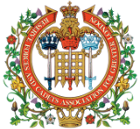 The Royal Observer Corps
The Royal Observer Corps
The Royal Observer Corps was a uniformed organisation that enjoyed a long association with the Royal Air Force. The badge of the Royal Observer Corps depicts a beacon lighter of Elizabethan times; these beacon lighters were recruited from the local population and were organised and paid by the County Sheriff, to care for and light the warning beacons in the event of approaching danger, time enough for Sir Francis Drake to finish his game of bowls. The motto of the Royal Observer Corps was: Forewarned is Forearmed.
Initially, recruitment was an all-male preserve until woman observers were admitted to the Corps in August 1941. Headquarters Observer Corps came to RAF Bentley Priory in July 1936, along with Air Chief Marshal Sir Hugh Dowding, who had been appointed Air Officer Commanding-in-Chief of the newly formed Fighter Command and of which the Observer Corps was to play an integral part. At this time, the Corps' first Commandant, Air Commodore E A Masterman, retired and was succeeded by Air Commodore Warrington-Morris, formerly Commandant of Southern Area Observer Corps, located at RAF Bentley Priory but soon to relocate to RAF Uxbridge from where Headquarters Observer Corps had so recently moved. From the beginning of WW2 through to 1955, the function of the Observer Corps was to report all aircraft movement over land and offshore to their respective centres and from there the information was related to the RAF Reporting and Control Network. During WW2, this service was provided 24 hours a day.
The Observer Corps was one of the cornerstones of Dowding's air defence system and he said later in his despatch on the Battle of Britain, “It is important to note that at this time they [the Observer Corps] constituted the whole means of tracking enemy raids once they had crossed the coastline. Their work throughout was quite invaluable. Without it the air-raid warning systems could not have been operated and inland interceptions would rarely have been made.” As the Air Chief Marshal in charge of the air defence of London and South-East England in 1940, Sir Keith Park was the Field Commander of the most critical area of the country during the Battle of Britain. Using a radar defence system and information gathered from the Observer Corps, Park carefully followed the movements of the bombers and fighters, constantly feeding information to his intercepting squadrons. In 1941 King George VI awarded the Observer Corps its ‘Royal' title in recognition of its role in the Battle of Britain.
Post 1955, the Royal Observer Corps went into protected accommodation and undertook the monitoring of radioactive fallout in the event of a nuclear strike on the United Kingdom. The resultant warnings would have been issued to the military and civilian population alike. The bulk of the Royal Observer Corps, approximately 9,600 members, were stood-down on 30th September 1991 with a much smaller cadre remaining until 31st December 1995. With the exception of 69 full-time Officers, all members of the Royal Observer Corps were volunteers.
Aims of the Royal Observer Corps
The Royal Observer Corps was a civil defence organisation, composed mainly of civilian volunteers, under the command in succession of the War Office, the Air Ministry and finally FAR Strike Command and the operational control of the Home Office.
Initially (1925-1955), it was tasked with identifying and tracking hostile aircraft or missiles flying over the UK or the seabelt adjoining the coastline. During D Day Landings, the Corps provided armed merchant vessels and all US Navy ships with experienced aircraft observers who controlled all anti-aircraft fire from these vessels. During WW2, it also assisted friendly aircraft which were lost or in distress. Later (1955) it was given the nuclear warfare analysis and fallout warning role until its final stand down in 1995.
Rank Structure
Air Commodore, RAF: Commandant ROC
Observer Captain, ROC: Deputy Commandant ROC (1941-1983) Chief of Staff, Area Commandant
Observer Commander, ROC: Senior staff duties, e.g. admin, Operations, Deputy Area Commandant, Senior Officer
(1992-96)
Observer Lieutenant Commander, ROC (full-time officers only)
Observer Lieutenant, ROC: ops training, admin, other staff duties. Obs Lt was also the entry level for full-time ROC officers
Observer Officer ROC: held under Royal Warrant, crew, nuclear reporting and group officer position
Chief Observer ROC: held under Royal Warrant, crew, nuclear reposting and group officer position
Chief Observer ROC: senior other rank (three bar) crew or nuclear reporting supervisor or head post observer
Leading Observer ROC: (two bar) crew or nuclear reporting supervisor or post instructor
Observer ROC: crew, nuclear reporting or post observer
The function almost dormant until revitalised by a sub-committee of the Imperial Defence appointed to investigate the aerial defence of SE England.
Special Constables. This rapidly expanded to include Hampshire, Suffolk, Surrey, Essex, Hertfordshire and Buckinghamshire.
Structure within area covered by Greater London:
Although during WW2 there were posts and clusters under group control nationwide, the defence of London was the highest priority. This involved literally hundreds of posts and clusters throughout SE England. Within London, its distribution was determined primarily by building height, with command and control centres underground wherever land-line communications could be easily established by the general Post Office, e.g. disused London Underground stations, viz: Aldwych, Highgate, South Kensington, South Kentish Town and under Waterloo Station.
When the Corps took on its nuclear reporting role (1965-1995) its distribution of posts within London was limited to eight, viz:
(Current Borough)
(one estimate)
(another estimate)
During WW2 each Group commanded some thirty to forty posts, each about ten miles from the other. By 1945, there were some 40 Groups controlling more than 1,000 posts or clusters throughout the UK, less Northern Ireland which came on-stream with the nuclear threat in 1954.
After disbandment, the Royal Observer Corps banner presented by Her Majesty Queen Elizabeth II at a Royal Review of the Corps at RAF Bentley Priory on 25th July 1991, was lodged for safekeeping in the rotunda of College Hall, RAF Cranwell.
